As I said, V4s offer certain ADvantages and DISADvantages (which is also true for inline 4s and indeed all other configurations). Inline 4s are also used in MotoGP and, in fact, have captured the last two titles (and are currently leading in this year's title, despite being outnumbered by V4s). Also, if you go back to 2004, V4s and I4s are evenly split in terms of MotoGP titles. V4s have won titles under three riders while I4s have done so under four riders, so an argument could be made that I4s are more rider-friendly. So, believe what you want, the facts are clear that no configuration is a clear favourite in all regards. Carry on...if the v4 did not offer adavantages, it would not be used in moto gp racing. the most powerful naturally aspirated production stock motorcycles on the dyno are all v4 engines. and yes mainstream manufacturers stopped making them because they are costly to manufacture. ducati and aprilia have all their flagship bikes built with v4 power. they have incredible sound and power. and can be made to be extremely light and compact. the lightest stock motorcycles in production with 1000cc and over engines. the ducati superleggera v4 is 335 pounds in racing trim. a ducati superleggera will not be the most reliable bike you will ever own, but it will certainly give you the greatest thrills you will ever experience. not for the faint of heart. ducati and aprilia d'ont mind the extra cost. they cater to a different clientele.
- Home
- Forums
- Motorcycles, Boating, Small Engine, Aviation, Powe
- Motorcycles and Motorcycle Lubrication
You are using an out of date browser. It may not display this or other websites correctly.
You should upgrade or use an alternative browser.
You should upgrade or use an alternative browser.
Why is the V-4 so underutilized in motorcycles?
- Thread starter grampi
- Start date
- Status
- Not open for further replies.
Soichiro Honda believed the perfect motorcycle engine is the V4... why
because if you are an engineer the V4 sports more advantages than an
I4... based on these physical facts...
.
1) Cube-like crankcase are inherently more rigid than the longer,
beam-like case of an I4 engine.
2)Long I4 crankshaft weights more than an V4...
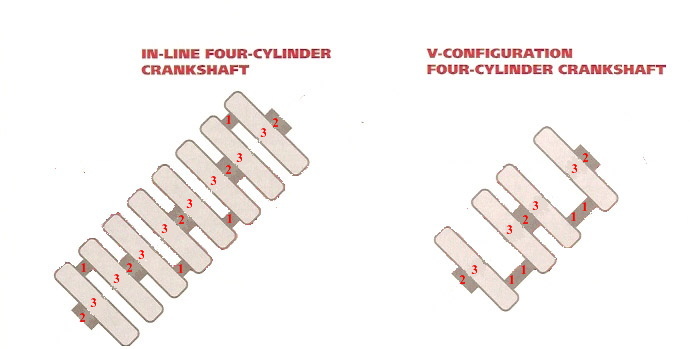
3)Short V4 crankshaft has less distance to travel and thus takes
less physical effort to change direction than I4...

4) 90º V4 has perfect primary balance, a great improvement over
the buzzy, second-order vibration of an I4...
5)A V4 has less internal crank bearing friction and able to spin up
faster and deliver more rear wheel HP...
6) A narrow V4 affords up to a 35% reduction in aerodynamic drag over
the wide I4...
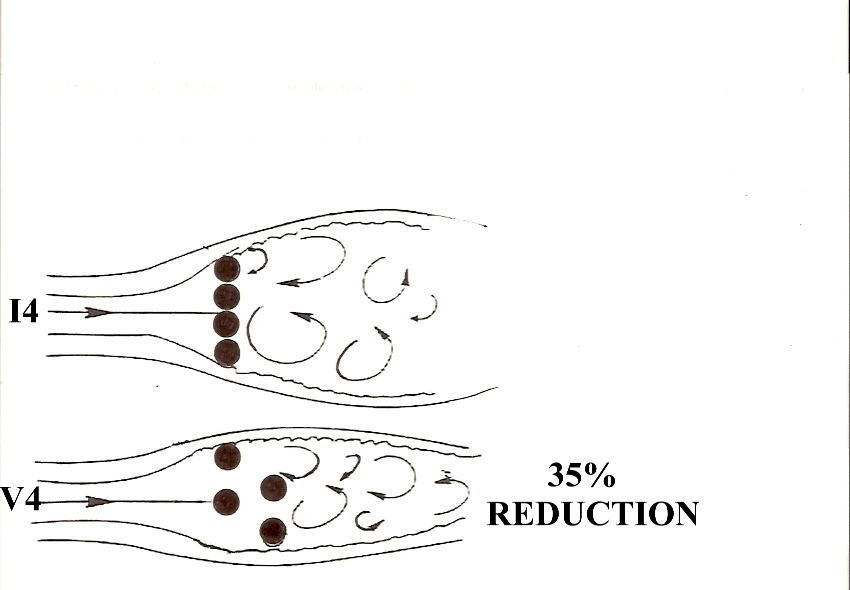
The disadvantages of a V-4 are mostly down to build costs. Two
cylinder heads, two sets of cams, two pairs of cylinders, two cam
drives and a more intricate cooling system...
because if you are an engineer the V4 sports more advantages than an
I4... based on these physical facts...
.
1) Cube-like crankcase are inherently more rigid than the longer,
beam-like case of an I4 engine.
2)Long I4 crankshaft weights more than an V4...

3)Short V4 crankshaft has less distance to travel and thus takes
less physical effort to change direction than I4...

4) 90º V4 has perfect primary balance, a great improvement over
the buzzy, second-order vibration of an I4...
5)A V4 has less internal crank bearing friction and able to spin up
faster and deliver more rear wheel HP...
6) A narrow V4 affords up to a 35% reduction in aerodynamic drag over
the wide I4...

The disadvantages of a V-4 are mostly down to build costs. Two
cylinder heads, two sets of cams, two pairs of cylinders, two cam
drives and a more intricate cooling system...
Negative... V4 sports more advantages than an I4... the V4 and I4 never were and never will be equal in the eyes of the engineers...So, believe what you want, the facts are clear that no configuration is a clear favourite in all regards. Carry on...
2022 MotoGp line up by configuation...
V4 21
I4 6
And former Yamaha engineer and MotoGP team manager Masao Furusawa preferred the inline-4 and Yamaha went on to win multiple MotoGP titles as a result. This success continues to this day, with the 2020 and 2021 MotoGP titles going to I4 bikes. Suzuki, upon coming to MotoGP, initially went the V4 route, finally pulling the plug due to a lack of success. They returned years later with an I4 and proceeded to win their first MotoGP title since 2000 (in 2020)... Also, every WSBK title since 2015 has been won by an I4-powered bike... carry on...Soichiro Honda believed the perfect motorcycle engine is the V4... why
because if you are an engineer the V4 sports more advantages than an
I4... based on these physical facts...
.
1) Cube-like crankcase are inherently more rigid than the longer,
beam-like case of an I4 engine.
2)Long I4 crankshaft weights more than an V4...

3)Short V4 crankshaft has less distance to travel and thus takes
less physical effort to change direction than I4...

4) 90º V4 has perfect primary balance, a great improvement over
the buzzy, second-order vibration of an I4...
5)A V4 has less internal crank bearing friction and able to spin up
faster and deliver more rear wheel HP...
6) A narrow V4 affords up to a 35% reduction in aerodynamic drag over
the wide I4...

The disadvantages of a V-4 are mostly down to build costs. Two
cylinder heads, two sets of cams, two pairs of cylinders, two cam
drives and a more intricate cooling system...
pray tell who is leading the championship? Who won in 2020 and 2021?Negative... V4 sports more advantages than an I4... the V4 and I4 never were and never will be equal in the eyes of the engineers...
2022 MotoGp line up by configuation...
V4 21
I4 6
thanks
Furusawa was stuck with the I4 because it was tired to Yamaha product line... his solution to the user friendly V5 was the "Virtual V4" the cross plane crank I4... Yamaha's old cammy hit I4 (2001 2004) was dead and buried as far as the MotoGp engineers were concerned...And former Yamaha engineer and MotoGP team manager Masao Furusawa preferred the inline-4 and Yamaha went on to win multiple MotoGP titles as a result.
Yamaha's own cadcam I4 versus V4 wheelbase study...
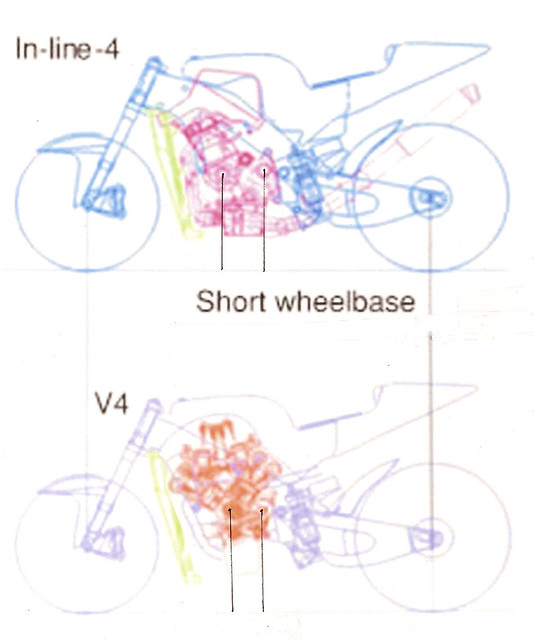
You're not alone grampi...It is by far the best engine design for motorcycles. It produces all of the gut wrenching bottom end torque of a V-twin, and produces all of the high RPM HP of the inline 4s. There is no down side to this engine design, yet it's found in very few motorcycles. I wonder why?
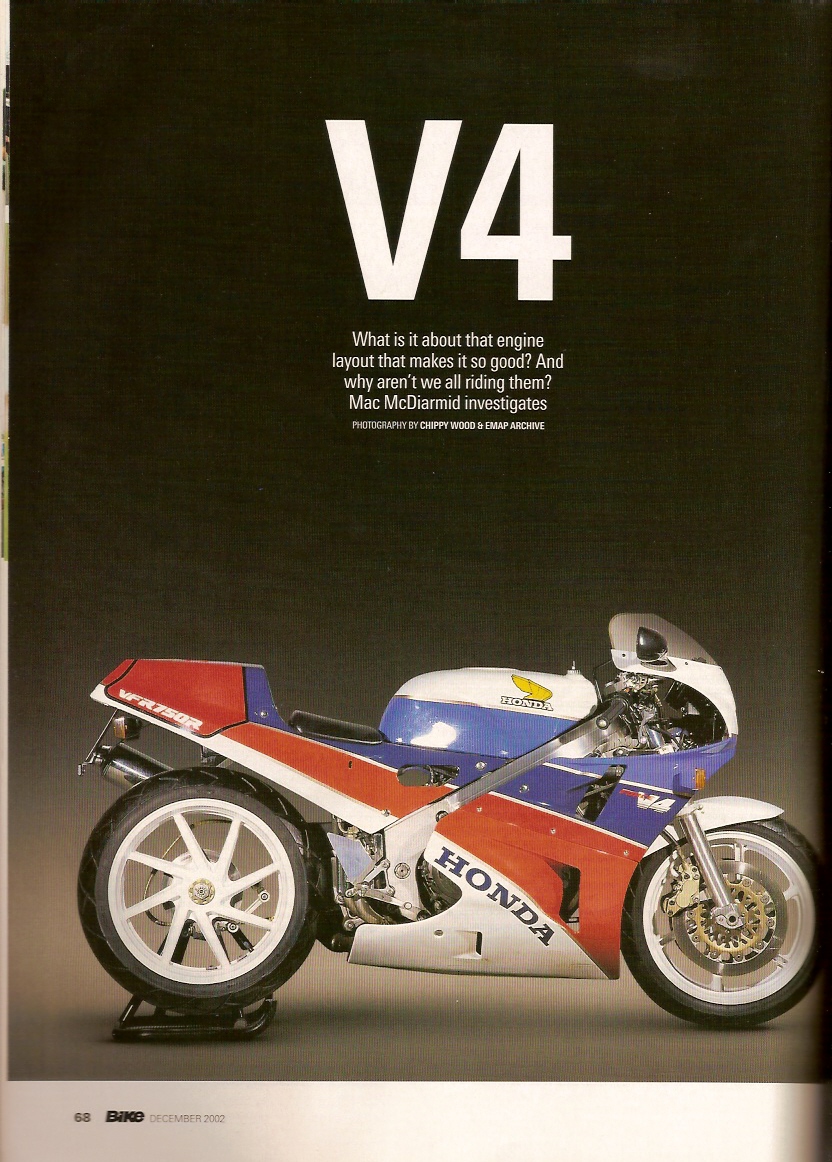
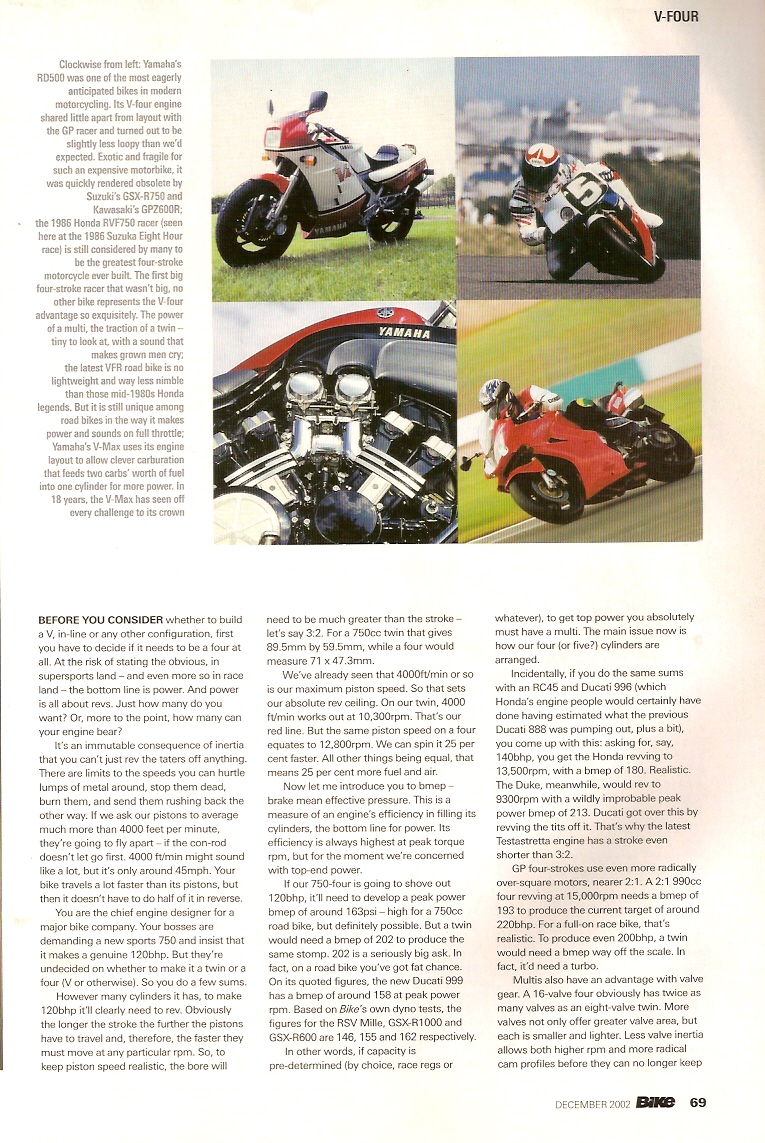

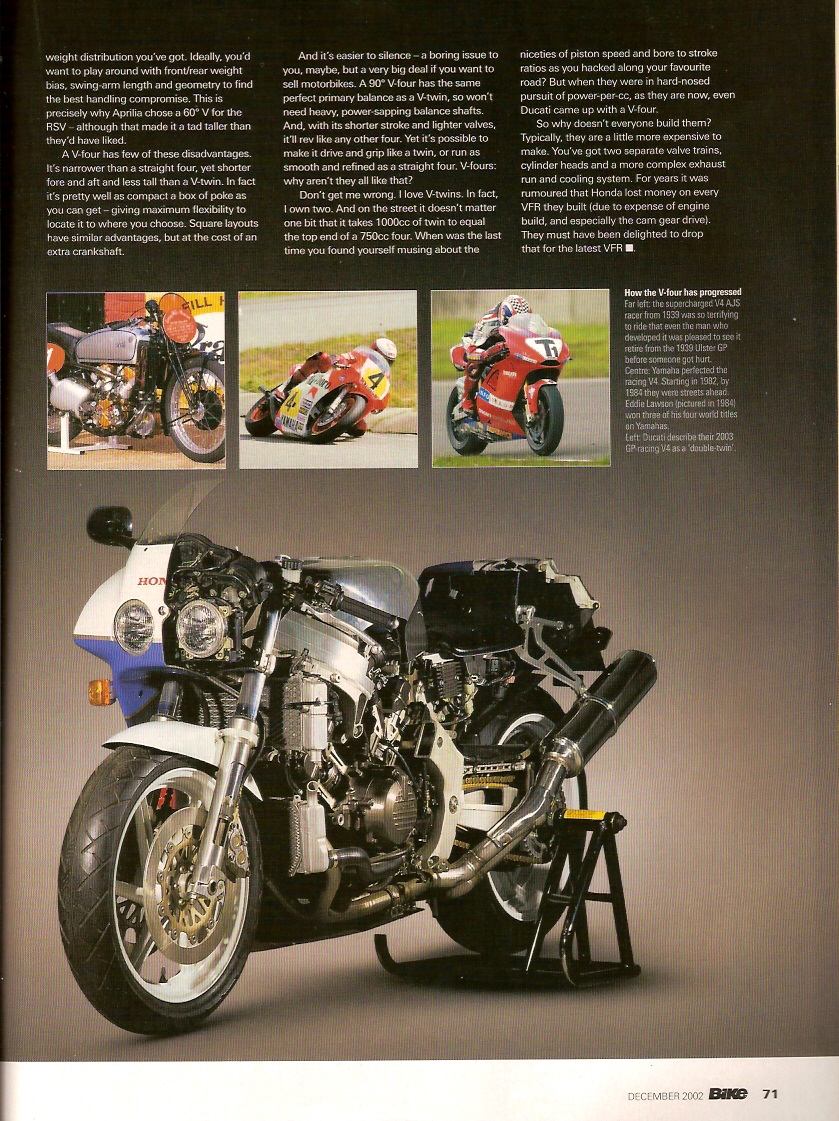
You're welcome... a "virtual V4" won in 2020 and 2021 and a "virtual V4" is currently leading the championship... like I said the old cammy hit I4 screamer is dead and buried in MotoGp...pray tell who is leading the championship? Who won in 2020 and 2021?
thanks
Virtual nothing, it's a crossplane I4. Just as there are flatplane and crossplane V8s, 360-degree and 180-degree V4s, or Ducati's Twin Pulse V4 configuration, engineers are free to phase the crank as they see fit (just as Yamaha, Honda and Triumph have gone to 270-deg cranks on their parallel twins and KTM chose a 285-degree crank on its engines). Furusawa saw value in going to a crossplane set-up and Suzuki has since followed suit (interestingly, Honda has played with a few different crank phasings on its MotoGP engines over the years). BTW, itonic how Suzuki had to go to an inline 4 to winYou're welcome... a "virtual V4" won in 2020 and 2021 and a "virtual V4" is currently leading the championship... like I said the old cammy hit I4 screamer is dead and buried in MotoGp...
P.S. How long before the synthetic oil molecule sketches come out? LOL
Virtual nothing, it's a crossplane I4.
The Yamaha was nothing until it crossed over to a "virtual V4"...
Quote Michael Scott respected MotoGP journalist for 40 years
"The Yamaha was the underdog, very much the junior to the
V5 Honda. The answer lay in the exhaust note.
Rossi's bike growled rather than howled. The
upgrade Yamaha had promised their new rider ran
deep. It was nothing more than a revival of the
same sort of Big Bang principal that had served
Honda so well in 1992. In the modern context,
it turned an in-line engine into a virtual V4. Most
importantly, it made the bike more friendly to
the rider, kinder to the tyres and easier to ride to
the limit. During the season, Suzuki, Ducati and
Proton would follow on with revised "Big Bang"
or "Long Bang" firing intervals of their own.
Kawasaki were the only exception, for Honda's
V5 had this characteristic built in."
Chinese are developing V4 m/c engines.
https://motorbikewriter.com/chinese-company-benda-debuts-two-new-v4-engines/
https://motorbikewriter.com/chinese-company-benda-debuts-two-new-v4-engines/
So from what I gather here in these posts.
V-4s are more expensive to make, more powerful, faster in many cases but not all (which one says Yami went in-line) is great for a race bike in many cases but not great for the consumer roaming around the country, touring, running to the stores to buy milk, cruises in the mountains ya da ya da.
Translated = my perception = the general public could care less as cost, maintenance, longitivtiy, reliability and handling is key to the consumer of which 99.8% never take their bike on a racing circuit.
I guess I feel the same way about my SUV and Mazda sedan, its the package and use, not the engine.
V-4s are more expensive to make, more powerful, faster in many cases but not all (which one says Yami went in-line) is great for a race bike in many cases but not great for the consumer roaming around the country, touring, running to the stores to buy milk, cruises in the mountains ya da ya da.
Translated = my perception = the general public could care less as cost, maintenance, longitivtiy, reliability and handling is key to the consumer of which 99.8% never take their bike on a racing circuit.
I guess I feel the same way about my SUV and Mazda sedan, its the package and use, not the engine.
shaft drive didnt help that - my riding buddies nicknamed it "the tractor" because of its enormous low end torque.Liked my V65 Sabre. Handsome in Maroon and Black. Very heavy bike.
Proof, which some seemingly struggle with, that the engine is but one part of the COMPLETE package. Most rational people will acknowledge that all engine configuration have their pros and cons. Judging by the results on race circuits around the world, it's a toss-up.
Do tell, what is the IDEAL firing sequence for a four-cylinder engine? BTW, you should perhaps share the info with Ducati, Aprilia, KTM and Honda, because they have all experimented with different set-ups over the years. Guess they couldn't reach you for your wisdom, LOL...The Yamaha was nothing until it crossed over to a "virtual V4"...
Quote Michael Scott respected MotoGP journalist for 40 years
"The Yamaha was the underdog, very much the junior to the
V5 Honda. The answer lay in the exhaust note.
Rossi's bike growled rather than howled. The
upgrade Yamaha had promised their new rider ran
deep. It was nothing more than a revival of the
same sort of Big Bang principal that had served
Honda so well in 1992. In the modern context,
it turned an in-line engine into a virtual V4. Most
importantly, it made the bike more friendly to
the rider, kinder to the tyres and easier to ride to
the limit. During the season, Suzuki, Ducati and
Proton would follow on with revised "Big Bang"
or "Long Bang" firing intervals of their own.
Kawasaki were the only exception, for Honda's
V5 had this characteristic built in."
Ride a Bandit 1250 and you'll also be blown away by the low-end power... and it's an I4. The torquey V4 thing is an urban legend promoted by many who should know better. FWIW, I fell in love with the Sabre and Interceptor 750s when they came out, and would love to get an Aprilia 1100...shaft drive didnt help that - my riding buddies nicknamed it "the tractor" because of its enormous low end torque.
BTW, quoting an ill-informed article lends no credibility or proof to your musings... If Scott was worthy of the "respect" you allude to, he wouldn't have written such tripe... Crankshaft phasing is a design parameter, just like bore, stroke, valve sizes, compression ratio...The Yamaha was nothing until it crossed over to a "virtual V4"...
Quote Michael Scott respected MotoGP journalist for 40 years
"The Yamaha was the underdog, very much the junior to the
V5 Honda. The answer lay in the exhaust note.
Rossi's bike growled rather than howled. The
upgrade Yamaha had promised their new rider ran
deep. It was nothing more than a revival of the
same sort of Big Bang principal that had served
Honda so well in 1992. In the modern context,
it turned an in-line engine into a virtual V4. Most
importantly, it made the bike more friendly to
the rider, kinder to the tyres and easier to ride to
the limit. During the season, Suzuki, Ducati and
Proton would follow on with revised "Big Bang"
or "Long Bang" firing intervals of their own.
Kawasaki were the only exception, for Honda's
V5 had this characteristic built in."
and yet both engine designs have won 9 titles since 2004, with I4s having both the two most recent, despite being vastly outnumbered... odd Hint: MotoGP are not drag races
- Status
- Not open for further replies.
Similar threads
- Replies
- 34
- Views
- 3K
- Replies
- 44
- Views
- 3K
- Replies
- 10
- Views
- 5K
